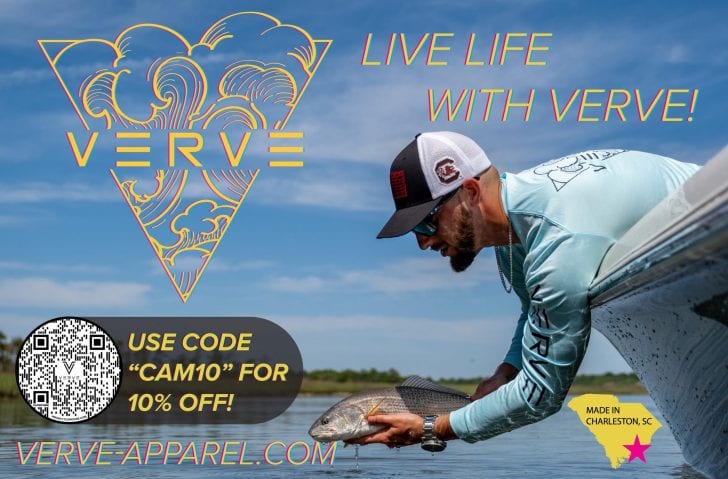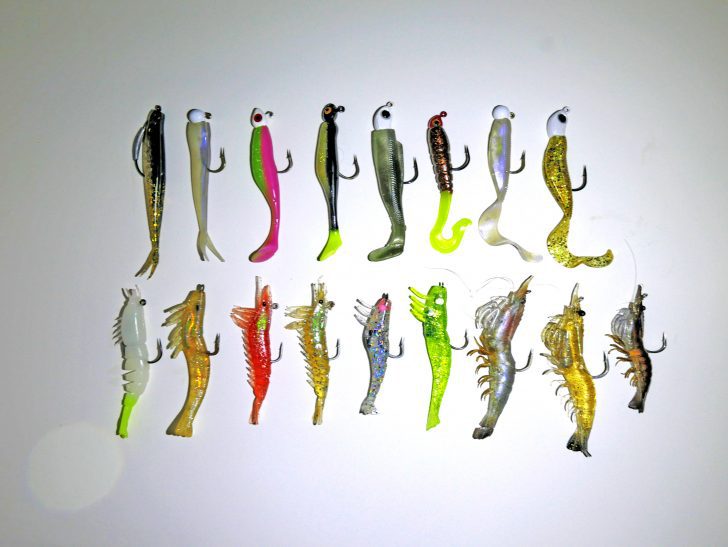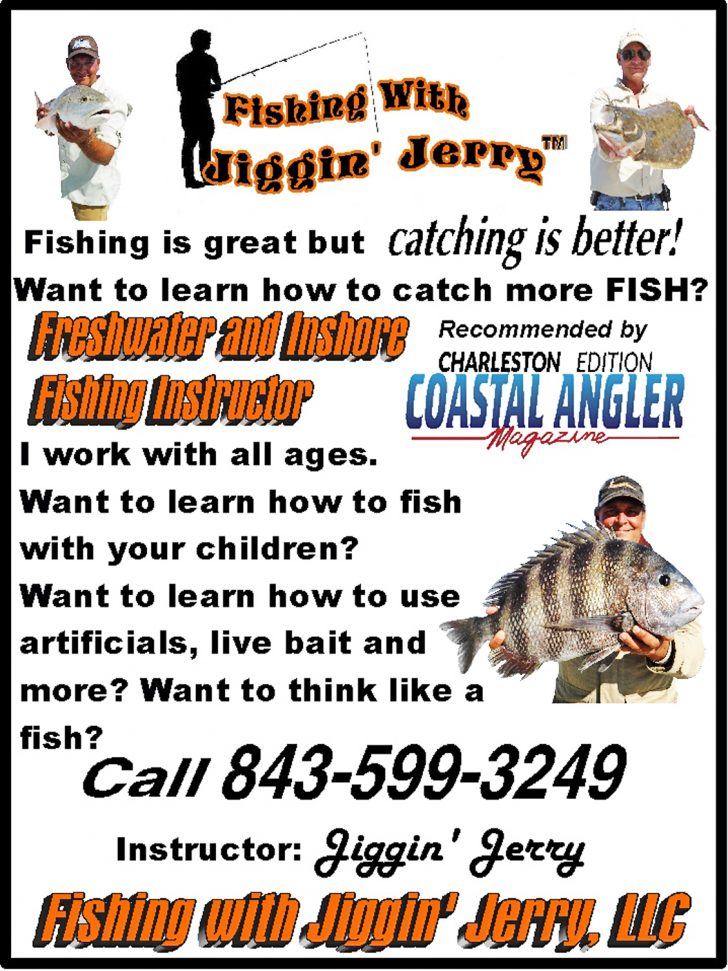Focus On Fishing | Jiggin Jerry | August 2021
It is August in the Lowcountry, and we now officially have just under two months left of summer before the first day of autumn arrives on September 22nd. The inshore water temperatures are at their max. Some inshore species will try to congregate in deeper holes where the water is cooler.
Others will wait for high tide to move into the grasses and the small creeks and flats to feed aggressively, chasing live Shrimp, Crabs and small fish like Finger Mullet and Mud Minnows, and a large number of inshore anglers love to cast a number of artificials that resemble these marine species. One of the best ways to do this is by using soft plastic lures.
Yes, there are hard plastic baits that can handle the job. They come in all shapes and sizes but nothing moves like a soft plastic artificial. But, what is the right soft plastic lure for the job?
This will depend on your location, the depth of the water you are fishing and the technique you are using. The three most popular soft plastic lures when it comes to inshore fishing are Paddle Tail Grubs, Curly Tail Grubs and artificial Shrimp.
There are a large number of manufacturers that are now producing these types of soft plastic lures. Some of the most popular are D.O.A., SaltWater Assassin, Z-Man, Live Target and Vudu. So, let’s discuss how each one of these soft plastics work.
What is the right soft plastic lure for the job? This will depend on your location..
Let’s take a Paddle Tail Grub vs. a Curly Tail Grub. Let’s keep in mind that artificial Grubs do come in different sizes. One of the most common sizes is three-inch, but you can find them a lot larger.
So, what would be the drastic difference between a Curly Tail and a Paddle Tail? When you reel them in, both types of tails wiggle. The Paddle Tail Grub’s tail wiggles left to right, and the Curly Tail Grub’s tail flutters with a snake-like motion and the very end of its tail moves left to right.
But, there are differences that will change the lure’s presentation. One is casting distance. A Paddle Tail Grub will cast further.
The reason is because the Paddle Tail flies through the air more like a dart, and its tail does not catch much wind, whereas a Curly Tail Grub’s tail catches a lot of wind, slowing the lure down in the air, reducing the distance you can cast. Now knowing this will help you understand how they both move and descend in the water.
Let’s say we are targeting Spotted Seatrout in a 20-foot deep hole during an outgoing tide, and the water is moving quickly, and you would like to cast a Grub of a particular color into that hole using a quarter-ounce jig head.
You have one in Paddle Tail and one in Curly Tail. Your goal is for your soft plastic bait to reach around 18 feet before the current drags it out of the hole so you can successfully target the Spotted Seatrout.
The Curly Tail Grub descends slowly into the water because just as if you were casting, the Curly Tail catches the current and slows the plastic bait down.
Therefore, you would want to use the Paddle Tail Grub. It will descend quicker, dropping head first like a dart towards the bottom, allowing you to reach the strike zone and work on your presentation before the current can pull your lure out of the hole.
Now let’s change our scenario. We are now fishing and targeting Spotted Seatrout and Red Drum in eight feet of water near a grass line with a cluster of Oysters on the seabed.
The object would be to cast a plastic lure towards the grass line and bring it through the strike zone around six-feet deep and either successfully entice and hook your game fish or retrieve your lure before the lure reaches the bottom.
Now that you know that the Paddle Tail Grub casts further but drops quickly and would take a faster retrieve, moving it out of the strike zone faster, trying to keep it from getting hung up in the Oysters, you would obviously want to use a Curly Tail Grub.
You should easily be able to make a cast to the grass line, and the Grub should drop slow enough to cover plenty of water before dropping to the bottom, allowing you more time to work your presentation and retrieve your lure or hook the fish you had targeted.
Another popular soft plastic lure is artificial Shrimp. The first thing we would like about an artificial Shrimp is to look as real or like a Shrimp as possible. After all, we are trying to trick our game fish into believing that they are real. So, what are the differences between one artificial Shrimp or another?
Please remember, like the Grubs, artificial Shrimp come in different sizes, but the most popular sizes are three-inch and four-inch, and different manufacturers design artificial Shrimp that differ from each other.
The first thing we would like about an artificial Shrimp is to look as real or like a Shrimp as possible..
Some I chuckle to say don’t look like Shrimp at all. We would want to refrain from using those artificial Shrimp.
Live Target manufacture one of the most realistic artificial Shrimp on the market.
The Shrimp are made of a stiffer soft plastic. This means that the body of the Shrimp will not move realistically in the water but yet still works quite well.
Vudu artificial Shrimp are designed with a cloth material molded in with the body, allowing them to form the tails of the artificial Shrimp in split sections.
This gives the artificial Shrimp a lot of body movement and helps attract and entice game fish into a reaction strike, a well made and attractive artificial.
D.O.A. has been making artificial Shrimp for a long time. The design of their Shrimp is basic and comes in a large number of colors. It has a stiff soft plastic body and is almost straight and eight straight peg legs and two protruding eyes.
The large Sheepshead is not even aware that he has just grabbed your jig head and the light fishing line is coming out of his mouth.
He starts to slowly move away, you tighten up the line, and in an instant, set the hook. The fight is on! Your drag is set just right.
This is a very popular Shrimp. They work under popping corks very well, and depending on the angler’s experience with a fishing rod, they can be twitched around and reeled in, creating a darting action and swimming presentation that works quite well.
Each one of these company’s Shrimp will come in different weights. Some of these Shrimp will allow for added weight.
The choice of which of these company’s Shrimp to use will be left to the angler. In my experience, Live Target and Vudu Shrimp work better in deeper water, and I find D.O.A. Shrimp work fantastic in the shallows and grassy flats.
So, now that we discussed the differences in some of the soft plastic lures used today, I hope this will help you decide what is the right soft plastic lure for the job.
Like I always say, good luck out there and have fun fishing!
To view some fishing adventures, go to my YouTube Channel Fishing With Jiggin Jerry.
Follow me on Facebook Fishing with Jiggin Jerry.
You may also enjoy reading
Float Your Way To Fishing Success
How To Use Vudu Shrimp – Keep It Poppin’
Artificial Intelligence – Tools Of The Trade
Becoming a Puppeteer Fisherman







